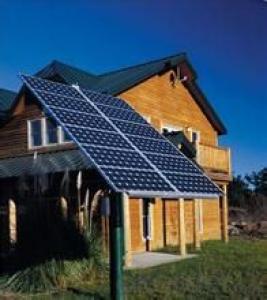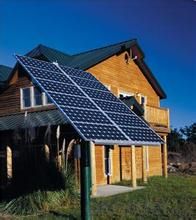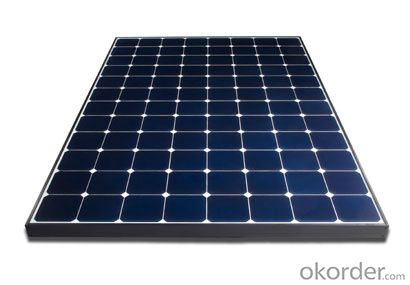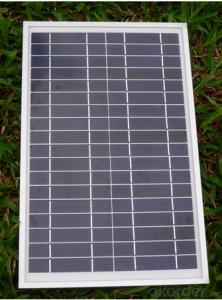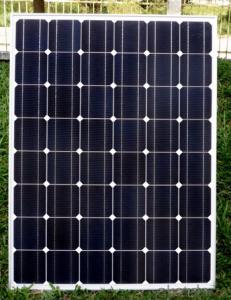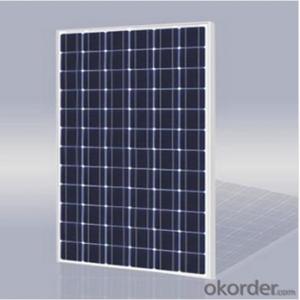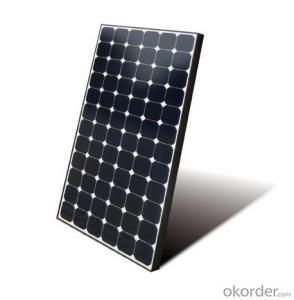570w A Grade Poly Solar Panel 290w with Cheapest Price
- Loading Port:
- Shanghai
- Payment Terms:
- TT OR LC
- Min Order Qty:
- 100 watt
- Supply Capability:
- 50000 watt/month
OKorder Service Pledge
OKorder Financial Service
You Might Also Like
Specification
Poly Solar Panel 290W A Grade with Cheapest Price
Product description
60 cell multi-crystalline solar module. 40mm natural anodised frame. IP65 rated Jbox, 1m solar cable and a pair of MC4 connectors.TÜV SÜD,SABS ISO 9001:2008 certified.
Nominal voltage refers to the voltage of the battery that the module is best suited to charge; this is a leftover term from the days when solar modules were only used to charge batteries. The actual voltage output of the module changes as lighting, temperature and load conditions change, so there is never one specific voltage at which the module operates. Nominal voltage allows users, at a glance, to make sure the module is compatible with a given system.
Open circuit voltage or VOC is the maximum voltage that the module can produce when not connected to an electrical circuit or system. VOC can be measured with a meter directly on an illuminated module's terminals or on its disconnected cable.
Solar panel conversion efficiency, typically in the 20 percent range, is reduced by dust, grime, pollen, and other particulates that accumulate on the solar panel. "A dirty solar panel can reduce its power capabilities by up to 30 percent in high dust/pollen or desert areas", says Seamus Curran, associate professor of physics at the University of Houston and director of the Institute for NanoEnergy, which specializes in the design, engineering, and assembly of nanostructures.[16]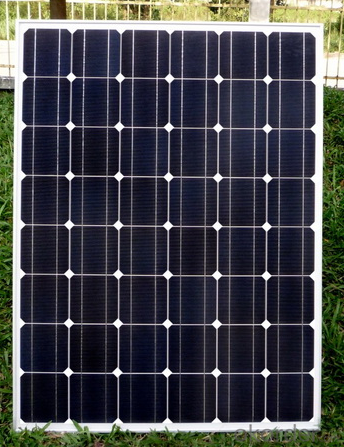
Application
Industrial
Commercial
Residential
Product feather
solar panel refers to a panel designed to absorb the sun's rays as a source of energy for generating electricity or heating.
A photovoltaic (in short PV) module is a packaged, connected assembly of typically 6×10 solar cells. Solar Photovoltaic panels constitute the solar array of a photovoltaic system that generates and supplies solar electricityin commercial and residential applications. Each module is rated by its DC output power under standard test conditions, and typically ranges from 100 to 365 watts. The efficiency of a module determines the area of a module given the same rated output – an 8% efficient 230 watt module will have twice the area of a 16% efficient 230 watt module. There are a few solar panels available that are exceeding 19% efficiency. A single solar module can produce only a limited amount of power; most installations contain multiple modules. A photovoltaic system typically includes a panel or an array of solar modules, a solar inverter, and sometimes a battery and/or solar tracker and interconnection wiring.
Packaging
24-26pcs into carton 312pcs for 20 foot container 712pcs for 40 foot container.
- Q: What is the payback period for solar panels?
- The payback period for solar panels refers to the time it takes for the savings from reduced energy bills to equal the initial investment in installing the solar panels. The payback period can vary depending on factors such as the cost of the panels, the amount of sunlight in the location, and the local electricity rates. On average, the payback period for solar panels is around 5 to 10 years, but it can be shorter or longer depending on these factors.
- Q: Where can I find updated info about solar panels for home?
- Of the practical technologies, crystalline silicon is still king. There have been improvements in manufacturing efficiency and price, but the fundamental technology is unchanged. For the past couple decades, there have been startups claiming that they will have a breakthrough available in 2 years, but so far, nothing has beat crystalline silicon for general applications. The appeal of thin-film was its cost, at the penalty of efficiency, but when the prices of crystalline plummeted, the cost argument went away. That wasn't the only problem Solyndra had, but it contributed to the company's demise. Organic solar cells show promise, and might ultimately be very cheap to manufacture, as they don't involve the high-temperature processing that semiconductors do. The main problem today is that they're not stable at the temperature of a hot roof. But then again, a few years ago, organic LEDs were the same way, and now they're commonplace in big TV's. Only time will tell. From a homeowner's standpoint, the install is routine, but still best done by professionals. It's like putting a new roof on a house, or wiring in central air conditioning. For most, it's better to call a pro.
- Q: Can solar panels be used in areas with high humidity?
- Yes, solar panels can be used in areas with high humidity. However, high humidity levels can affect the overall efficiency of solar panels due to a decrease in their performance. The moisture in the air can cause a film of dirt or dust to accumulate on the panels, reducing their ability to absorb sunlight effectively. Regular cleaning and maintenance can help mitigate these effects and ensure optimal performance.
- Q: Is there a cheaper way on how to make your own solar panels ? Can someone share their real life experience ? Thank you.
- On my website you can read my story of how my dad made solar panels at home for a little over $200, and now he pays nothing to the electric company.
- Q: Can solar panels be damaged by birds or other animals?
- Yes, solar panels can be damaged by birds or other animals. Birds may build nests or perch on the panels, causing blockage of sunlight and reducing their efficiency. Additionally, animals like squirrels or raccoons may chew on the wires or cables, leading to electrical damage. To prevent such issues, various measures like installing bird deterrents or using protective mesh can be taken.
- Q: I'm looking at solar panels and I have NO IDEA what this stuff means.They come in catagories of Watts. What does that refer to? If a solar pannel is in the 200-watt catagory, what does that really mean? Will it produce 200 watts an hour, a day, a week, a month, a year?? How many watts of energy does the average house use up in one month? I really wish they would just tell me on the website!! :(0 points!!!!!!!! :D
- This is not a precise analogy, but think of it this way: Volts is the pressure of the water in a pipe. Amps is the gallons per minute that come out. Watts is how much water you have after a certain length of time the pipe is open. a 200 watt solar panel under ideal conditions ( bright daylight between , say 0 am and 2 pm, held exactly flat to the sun ) will produce enough energy to run 2 00 watt light bulbs. You hardly ever have perfect bright sunlight; the length of the day varies during the year, and the angle of the panel to the sun changes from hour to hour; all this leads to a typical home in the US /Europe having only about 4 hours a day of maximum solar available. So, your 200 watt panel would give you 800 watts a day, enough to run one 00 watt light bulb for 8 hours If you are trying to run a house off solar, there are unfortunately other things needed between the panels and the lights / appliances; inverters, batteries, controllers sand each one eats up a little energy so you may get only 75 useful watts. See why more homes don't have panels? The other poster who said $30-50,000 to completely run a home on panels is about right.
- Q: Are solar panels suitable for commercial use?
- Yes, solar panels are suitable for commercial use. They offer numerous benefits such as reducing electricity costs, providing a reliable source of clean energy, and helping businesses meet sustainability goals. Additionally, advancements in technology have made solar panels more efficient and cost-effective, making them a viable option for commercial establishments of all sizes.
- Q: Can solar panels be used to power a sports stadium?
- Yes, solar panels can be used to power a sports stadium. By installing a sufficient number of solar panels on the stadium's roof or surrounding areas, the captured solar energy can be converted into electricity to power various systems within the stadium, including lighting, heating, ventilation, and other electrical equipment. This can reduce the reliance on traditional energy sources and provide a more sustainable and environmentally friendly solution for powering sports stadiums.
- Q: how the energy of load connected to solar PV measure.?Want too the basic idea about it.The role of current flowing thrugh the load?Can u explain with example..can explain simply?Im not an electrical student so explain very basics
- Most PV solar panels are labelled with their peak power output - this is the maximum power (measured in Watts) which that panel can generate in full sunlight. Remember these simple formula- V=IR and P=VI The current flowing through load keep the flow of electrons and thus energy is produced.
- Q: Can solar panels be installed on a carport or parking lot?
- Yes, solar panels can be installed on a carport or parking lot. This is known as solar carport or solar parking lot systems. They provide shade for parked vehicles while generating clean and renewable energy.
Send your message to us
570w A Grade Poly Solar Panel 290w with Cheapest Price
- Loading Port:
- Shanghai
- Payment Terms:
- TT OR LC
- Min Order Qty:
- 100 watt
- Supply Capability:
- 50000 watt/month
OKorder Service Pledge
OKorder Financial Service
Similar products
Hot products
Hot Searches
Related keywords
